Introduction
The introduction of artificial intelligence (AI) into the oil and gas industry represents one of the most significant transformations in the modern industrial sector. Against the backdrop of global changes in the economy, ecology, and technology, the oil and gas industry faces the necessity of adapting and finding new ways to enhance efficiency and reduce costs. Amid increasing complexity in resource extraction, declining easily accessible reserves, and heightened environmental requirements, AI emerges not just as an innovative tool but as a strategic factor capable of ensuring the industry's sustainable development.
The development of AI in the oil and gas sector began with the implementation of traditional analytical methods, which enable the automation and optimization of processes such as modeling and forecasting. However, the past decades have witnessed significant advancements in AI, especially with the advent of machine learning and generative models, offering new possibilities for addressing complex challenges facing the industry. In particular, generative AI enables the creation of models and forecasts that surpass traditional approaches in accuracy and speed, opening new horizons for exploration and field development.
The aim of this paper is to provide a comprehensive analysis of AI applications in upstream oil and gas, including a review of traditional and innovative methods as well as real-world examples of their successful implementation. The study will analyze the key stages of AI evolution in the industry, its current state, and future prospects. Special attention is given to examining how AI contributes to enhancing productivity, reducing operational costs, and improving environmental performance, which is critically important in today’s market conditions [1, p. 1-14].
Thus, this research offers a holistic understanding of the role of AI in the modern oil and gas industry, highlighting its potential to ensure sustainable and efficient development in the face of global challenges.
1. Evolution of Artificial Intelligence (AI) in the Oil and Gas Industry
The evolution of artificial intelligence (AI) in the oil and gas industry is a process that began with the advent of the first digital technologies and has led to profound transformations in approaches to resource extraction and processing. Historically, the oil and gas industry relied on mechanical and physical methods that demanded significant human and material resources. However, with the development of AI, a new era has dawned, where machines not only execute instructions but also analyze data, make decisions, and predict future outcomes, fundamentally altering the industry [2, p. 379-391].
As depicted in figure 1 (illustrating the evolution of the industry from early pioneers to the era of digital technologies and AI), both technologies and resource management approaches have evolved over time. In the mid-20th century, with the development of mechanical drilling and the exploration of deepwater fields, the gradual introduction of digital technologies began. These initial steps can be seen as a precursor to the next level–the full integration of AI into extraction and processing processes. Digitalization played a crucial role in laying the groundwork for AI adoption, enabling the collection and processing of vast amounts of data necessary for AI systems to learn and operate.

Fig. 1. Evolution of the industry
With the arrival of the 21st century, AI began to play a central role in the industry's development. Initially, AI was primarily used for analytical tasks such as data processing and interpretation from fields, modeling, and forecasting. Traditional AI allowed companies to automate routine processes, improve the accuracy of predictions, and enhance operational efficiency. However, its capabilities were limited by predetermined algorithms, leaving little room for adaptability and innovation.
Significant changes began to occur with the advancement of machine learning. This approach enabled AI systems not only to analyze data but also to learn from the information received, improving their predictions and decisions as more data accumulated. Machine learning became a powerful tool for optimizing drilling, well management, and performance forecasting. Specifically, machine learning significantly reduced decision-making time, increased prediction accuracy, and lowered operational risks.
The most substantial changes, however, occurred with the advent of deep learning and generative AI, which provided companies with entirely new tools for process management. Deep learning, based on multilayer neural networks, allows for the modeling of complex processes, such as fluid movement in reservoirs, with a high degree of accuracy. Generative AI, in turn, can create new models and scenarios based on minimal data sets, which is particularly important in the face of uncertainty and the complexity of modern challenges. Table 1 illustrates the difference between traditional AI and generative AI, where the latter significantly expands the possibilities for analysis and forecasting.
Table 1
The difference between traditional AI and generative AI
Aspect | Traditional AI | Generative AI |
| Description | Traditional AI uses analytical algorithms to solve tasks faster and more accurately than humans. It is used to describe, predict, or optimize data, helping to automate processes that previously required significant human resources. | Generative AI uses algorithms to create new content comparable to or even surpassing human capabilities. This technology synthesizes text, images, and data, opening new possibilities for creativity, analysis, and scientific research. |
| Examples of Use | - Forecasting trends: Used for analyzing large volumes of data to predict future trends, such as in marketing or finance. - Modeling processes: Applied in industry and science to create models of complex systems, such as manufacturing processes or biological systems. - Optimizing performance: Used to enhance the efficiency of various systems and processes, including logistics, production, and energy consumption. | - Creating concept art with DALL-E: Generative AI can create unique artworks by combining various visual elements, opening new horizons for artists and designers. - Knowledge synthesis with ChatGPT: Generative AI can process large volumes of text information, combining and interpreting it to generate new knowledge and ideas, which is useful for scientific research and educational purposes. - Drug discovery with AlphaFold: Generative AI can predict protein structures, accelerating the process of developing new drugs, significantly reducing costs and time. |
| Key Advantages | - High accuracy and efficiency in data processing and analysis. - Ability to automate routine tasks and improve decision-making. - Reduces human error and associated risks. | - Ability to create original content and new ideas that were previously unattainable. - Enhances creativity and innovation in various fields, from art to science. - Capable of solving complex problems, such as modeling molecular structures, that were beyond the reach of traditional methods. |
| Limitations | - Limited to analytical tasks that require well-structured data. - Less flexible in generating new solutions and ideas. | - High computational resource requirements. - Risk of generating unpredictable or incorrect results. |
Today, AI is not merely a tool for enhancing efficiency but a strategic factor determining companies' competitiveness. The current state of AI in the oil and gas industry reflects its integration into key business processes, from exploration and field development to production operations management and corporate planning. An essential aspect is that AI significantly improves the accuracy and speed of decision-making, as evidenced by the results achieved by companies actively implementing these technologies.
For example, table 2 demonstrates how companies use AI to achieve six primary goals, including increasing production, reducing capital expenditures, and enhancing safety. These results underscore the significant impact of AI on all aspects of the industry, confirming its importance as a tool for ensuring sustainable and efficient development.
Table 2
Companies are implementing AI/ML initiatives primarily to solve 6 problems
| Increased production | Day-to-day production increase from optimization using data-driven models and recommendations, and avoidance of unplanned production losses through condition-based and predictive alerts |
| Lower capital investments | Reduce capital investments from improved integrated planning and coordination with suppliers. Analytics can also reduce the number of wells needed through improved drainage strategies and smarter resource models |
| Lower operating expenditure | Operating expenditures avoided by reducing need for direct purchases of services and equipment due to digitalization, e.g. cancelling redundant 3rd party monitoring, extending equipment life times, optimize energy consumption |
| Increased worker productivity | Offshore and onshore work hours freed up through digitalization and eventually avoidance of manual work processes, e.g. monitoring, data retrieval and preparation, and reduction of calendar-based maintenance |
| Improved HSE | HSE improved by reducing manual work in the field, by improving safety recommendations related to issued work orders, and by automating reporting protocols |
| Increase resource access | Increase the asset pool accessible to the company or uncovering new resources that can be captured |
Examining current achievements, it is evident that AI is actively used to optimize production processes, prevent accidents, and reduce operating costs. These successes have been made possible by integrating AI into data analysis and operations management processes, enabling companies to cut costs and boost productivity. For instance, generative AI is employed to model complex geological structures, allowing for more accurate predictions of reservoirs and optimizing the drilling process. These technologies not only enhance efficiency but also reduce the risks associated with oil and gas exploration and extraction [2, p. 379-391; 3, p. 219-226; 4].
Thus, the evolution of AI in the oil and gas industry reflects a shift from traditional methods to new, innovative approaches that significantly improve efficiency, reduce costs, and enhance environmental performance. AI has become an integral part of strategic planning and operational management, playing a key role in ensuring the industry's sustainable development in the face of global changes.
2. Traditional AI Methods in Oil and Gas Production
The application of traditional artificial intelligence (AI) in oil and gas production has significantly transformed how data is handled and operations are managed in the upstream sector. These technologies have become an integral part of the modern production process, enhancing efficiency, reducing costs, and minimizing risks [5, p. 8211].
Figure 2 illustrates how traditional AI solutions are integrated into the value chain during the extraction and development phases. These solutions involve processing large volumes of data to improve the accuracy of geological interpretations, which in turn helps optimize decision-making at every stage of the production process. The visualization in the figure demonstrates typical areas where AI impacts productivity and efficiency in the context of onshore operations.
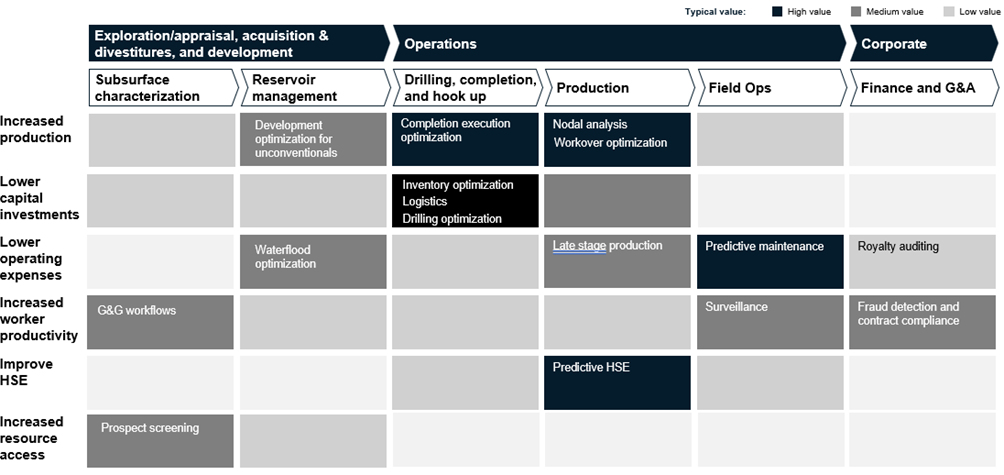
Fig. 2. Integration of traditional AI solutions into the value chain at the production and field development stages
One key example of AI application is the optimization of well completion. This process includes setting casing, packing, cementing, and installing equipment. Traditionally, these operations depend on the expertise of specialists, leading to variability in outcomes and potentially inefficient use of capital resources (Capex). However, AI can significantly improve these processes.
In the early stages of casing, packing, cementing, and equipment installation, AI can utilize machine learning to analyze data from past operations, allowing for the determination of optimal parameters for each specific well. This helps minimize costs and improve productivity. While traditional methods remain important in this process, future AI developments promise to make these procedures more precise and efficient.
The next critical stage is well perforation and stimulation, necessary for increasing productivity. Today, these operations are performed based on experience and expert judgment, which does not always yield the maximum result. AI can change this approach by using data from previous operations in similar geographical conditions to propose the most effective strategies. Figure 3 demonstrates how AI can be applied to analyze data and optimize the perforation and stimulation process, enhancing the accuracy and efficiency of operations.

Fig. 3. Application of AI for data analysis and optimization of the perforation and stimulation process
Drilling optimization is another example of effective AI utilization. Traditionally, the drilling process relies on specialists' experience and intuition, which can lead to suboptimal decisions and increased costs. AI enables the use of data from previous operations to create models that predict and optimize drilling. For instance, AI can analyze drilling data to determine the best rate of penetration (ROP) for each subformation, improving drilling efficiency and reducing equipment wear.
Table 3
Key features of using analytical AI to control the drilling process
Area | Key features | How it changes the way of working |
| Analytical AI to drive well progress | Recommendations for controllable drilling parameters | Transition to an ongoing drilling performance discussion, with quantified insights at hand A pilot in a complex formation yielded 2x the historic average drilling speed |
| Drilling bit choice strategy recommendations | Dynamically adjust bit strategy to actual performance based on data-driven decision support | |
| Sophisticated operations reporting to reduce NPT, enhanced by AI | Homepage to provide right information in proper hierarchy | Shift focus of morning calls to achieving best performance Tool as 'shared screen’ in onshore/offshore calls |
| Live drilling data contextualized with operations log and insights from rig and anomaly detection model | Engineers recognize anomalies during morning call and request contractor to replace parts proactively, or live during operations | |
| Global drilling lessons learnt register | Onshore supervisor, rig superintendent and engineers actively log lessons as operations happen Lessons register for formal project reviews |
Table 3 illustrates the key features of using analytical AI for drilling process management. AI can provide recommendations on controlled drilling parameters, significantly altering the management approach. In one pilot project implemented in a complex geological formation, AI usage doubled the historical average drilling speed, demonstrating the significant advantages of this technology. AI is also used for dynamically adjusting drilling strategies based on current data, allowing for adaptation to changing field conditions and improving overall drilling productivity.
An essential part of drilling optimization is reducing non-productive time (NPT). AI can assist by providing data and analytical tools to improve reporting and process management. Figure 4 shows how AI can be used for anomaly detection and improving operations management at the drilling site. Contextualizing drilling data with operational logs and anomaly detection models enables engineers to respond more quickly to changes, reducing unplanned downtime and increasing overall operational efficiency.

Fig. 4. Applying AI to detect anomalies and improve management of drill site operations
Well maintenance optimization is also a crucial area for AI application. Traditionally, maintenance work is conducted based on manually collected data, which requires significant time and financial resources. AI allows for automating the identification process of low-performing wells and suggesting optimal repair solutions. For example, AI can automatically visualize well performance data and propose the most effective repair strategies, helping reduce operational costs and improve production metrics.
AI also plays an important role in decision-making regarding maintenance. Today, such decisions are made at the corporate level, which may not be effective in specific field conditions. AI can automate the calculations of the net present value (NPV) of various options and suggest the optimal solutions based on historical data. Figure 5 shows how AI can be used to automate processes and improve maintenance efficiency, helping to reduce costs and improve asset management.

Fig. 5. Application of AI to automate processes and improve the efficiency of repairs
The final stage in this process is predictive maintenance, aimed at preventing equipment failures and minimizing operational risks. AI application in this area allows for predicting potential problems in advance, enabling timely preventive maintenance and avoiding major accidents. Figure 6 illustrates how AI can use sensor data for anomaly detection and equipment failure prediction. This reduces unplanned downtime and increases overall system reliability.
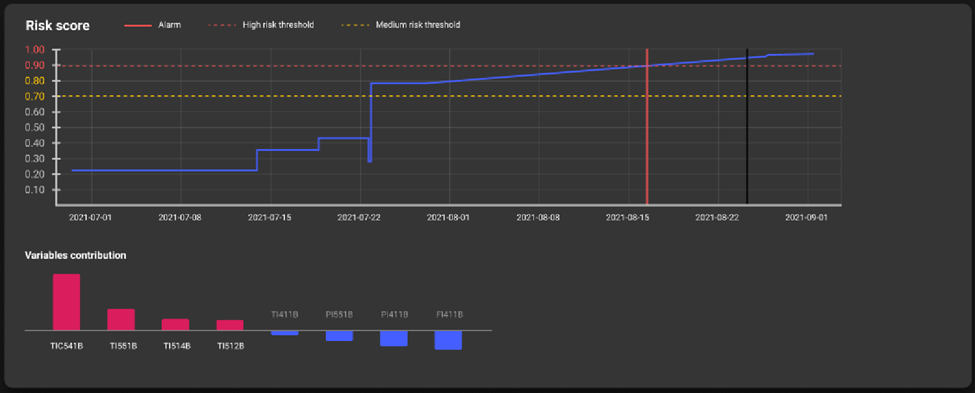
Fig. 6. Using sensor data for anomaly detection and equipment failure prediction
An example of using AI for predictive maintenance of compressors demonstrates how this technology can help avoid major breakdowns and reduce operating costs. Traditionally, equipment diagnostics and repair were conducted based on scheduled maintenance or after a failure occurred. AI enables the training of models that analyze equipment behavior data before a failure and use it to predict potential issues.
In addition, AI can be used to create asset monitoring dashboards that provide a comprehensive view of equipment status in real-time. Figure 7 shows an example of such a dashboard, where data from various sensors and systems are combined and analyzed, giving users the ability to make timely decisions based on current information.
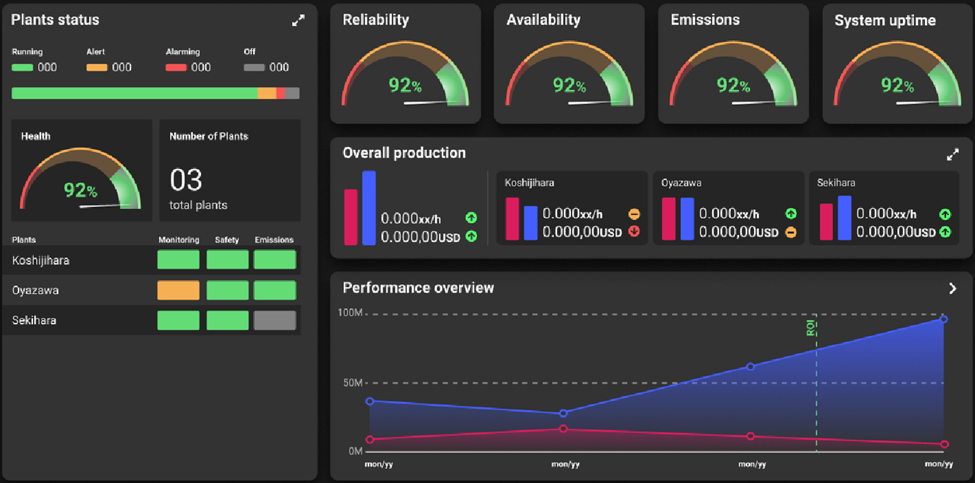
Fig. 7. Asset monitoring dashboard
Thus, traditional AI solutions in the oil and gas industry already provide significant improvements in operational efficiency and risk management. These technologies enable companies to adapt to new challenges and leverage data to enhance productivity, reduce costs, and improve asset management at all stages of the production process [5, p. 8211; 6, p. 1712; 7, p. 3571-3572].
3. Innovative AI Approaches in Upstream Oil & Gas
The implementation of innovative technologies in the oil and gas industry is opening new horizons for enhancing efficiency and optimizing processes. At the forefront of these changes are technologies like deep learning, generative AI (GenAI), and advanced project data analytics, which are already beginning to transform traditional approaches to project and operations management in the upstream segment [6, p. 1712].
One of the most promising technologies is Deep-Learning Surrogates. This technique has the potential to elevate reservoir modeling to new levels of speed and automation. Unlike traditional physical-mathematical models based on solving differential equations numerically, deep learning surrogate models replicate the behavior of physical processes using algorithms that mimic observed characteristics rather than predict behavior with mathematical precision. For instance, predicting airflow around an aircraft wing using traditional methods might take hours, while a similar simulation using surrogate AI can be completed in less than a second. Figure 8 illustrates this contrast, highlighting the significant reduction in computation time when using deep learning. Figure 9 demonstrates how deep learning surrogate algorithms can effectively replicate physical processes, providing not only speed but also high accuracy in modeling.

Fig. 8. Traditional algorithm

Fig. 9. Surrogate deep learning algorithms
Another innovative technology is Generative AI (GenAI), which can significantly enhance the competitiveness and flexibility of teams when working with new exploration spaces. GenAI can drastically speed up the review of hydrocarbon resources and make screening processes more efficient, creating a competitive advantage over other market players. For example, accelerated prospect evaluation and target prioritization allow for quicker decision-making, thereby increasing the chances of discovering new reserves. Table 4 illustrates how the application of GenAI can alter project timelines, reducing the time required for target generation and evaluation, decreasing the number of necessary analyses, and accelerating access to new land areas. This not only enables quicker achievement of key decisions but also reduces the costs associated with the decision-making process.
Table 4
Using GenAI to change the timeline of project work
Area prospectivity | Target prioritization | Target testing | |
| Unencumbered land access timeline | Ongoing – 10 targets/week | 1–2 months | 12+ months |
| Potential new timeline with GenAI | More targets generated / review | Potential reduction of up to 50% | Potential reduction in analysis time and #/location of sampling / drillholes |
| How GenAI can make a change | Augment explorations teams to become more competitive and agile in new search spaces by rapidly testing hypotheses against vast amounts of data from novel data sources | Accelerate target prioritization by enabling exploration teams to test hypotheses (including Above Ground Risks), while rapidly excluding non-prospective areas | Accelerate target testing using improved exploration plan design (discovery and appraise) and hypothesis testing to assure key decision points are met faster and at lower costs |
GenAI can also significantly improve goal-setting and hypothesis testing, which is particularly important in conditions of uncertainty and risk. For instance, GenAI can help teams rapidly test hypotheses based on large volumes of data from new sources, allowing them to quickly rule out non-promising areas and focus on the most likely targets. This approach enhances exploration planning efficiency, enables faster attainment of key decision points, and reduces costs. As shown in Table 4, the use of GenAI can reduce the number of appraisal wells needed to gather reservoir data and decrease the time and costs associated with drilling.
Another important area for applying innovative technologies is generative planning combined with advanced project data analytics. Generative planning helps optimize project execution plans, reducing timelines and costs by optimizing the sequence of actions and resource allocation. For example, before construction begins, generative planning can determine the strategy for executing work and then adapt it in case of significant changes. Managing the construction site as a production system based on capacity, productivity, and inventory also becomes more efficient with these technologies.
Key features of generative planning include the digital representation of the project, encompassing physical and spatial dependencies between elements, the structure of work with a bill of quantities, as well as "recipes" for task execution, such as formwork installation, reinforcement, and concreting. Generative planning allows for the modeling and optimization of task execution considering external conditions, ensuring the most efficient use of resources and minimizing costs. Figure 10 shows how generative planning can reduce project duration by more than 15% and labor and equipment costs by 10%, leading to an overall reduction in construction capital costs by up to 10%.
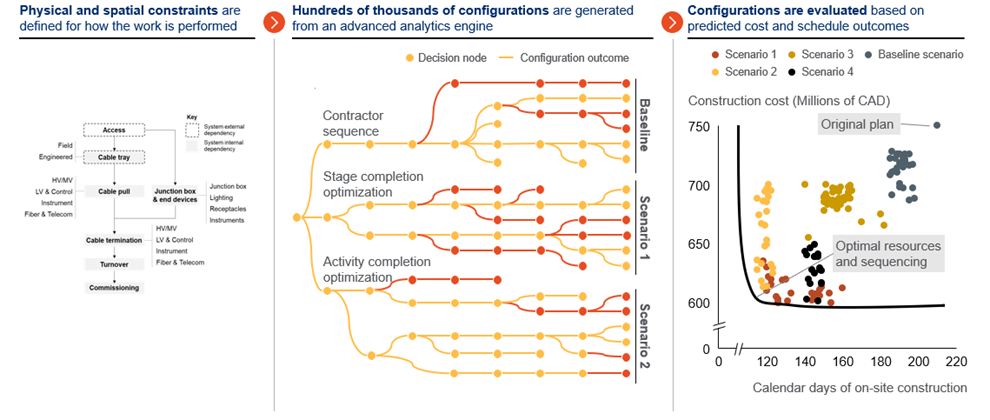
Fig. 10. Reducing project duration
Table 5
GenAI Enhances traditional scheduling
| Traditional scheduling (P6) | Generative scheduling |
| Application | Generate a project Master Schedule with a sequence based on series of assumed constraints Understand the critical path and controlling float on key milestones | Generate a project Master Schedule with an optimal sequence based on a series of purposefully tested constraints, resources, quantities and recipes Understand the critical path and controlling float on key milestones, as well as modelling the dynamism of the site environment with constantly changing inputs, constraints and progress (leveraging real-time site data) to guide fast and informed decision-making |
| Building a schedule | Produce a predictable sequence solution by requiring coordination between multiple individual schedules and referencing previous scheduler experience Determine activity durations based on historical performance and benchmarked rates or contractor's input embedding hidden buffer Design schedule to contractual requirements and key milestones as leading constraints Manually (time-consuming) create new activity sequences for comparison of scenarios | Produce an optimized sequence calculated with an advanced analytics engine in a few minutes from relationships between elements, construction processes, available resources, placement rates and bill of quantities Parametrically calculate activity durations using quantities, placement rates, resource availability, etc. generating transparency Design schedule to fastest sequence of activities for the lowest cost whilst meeting (or beating) contractual requirements Explore millions of possible resource loaded construction schedules and perform “what-if” analyses/comparisons |
| Managing a schedule | Reactively update schedule in response to site events and progress (typically once per month) Iteratively adjust resource allocation using existing schedule and changes to activity start dates Manually (time-consuming) create new sequences in response to emerging risks | Proactively support schedule update in response to progress (e.g., new production rates) and dynamic site conditions/ constraints Re-optimize resource allocation using “locked-in” activity sequence based on site progress and quantities/hours Rapidly re-sequence activities to identify improved cost/duration schedule and assess impact of emerging risks |
Table 5 illustrates how Generative AI enhances traditional scheduling. While traditional planning (P6) generates a project schedule based on assumed constraints and historical data, generative planning uses the optimal sequence of actions, validated against deliberately tested constraints, resources, quantities, and recipes. This allows for consideration of the dynamic conditions on the construction site and rapid decision-making, minimizing risks and costs.
In conclusion, innovative technologies such as Deep-Learning Surrogates, GenAI, and generative planning provide the oil and gas industry with new tools for enhancing efficiency and competitiveness. These technologies accelerate modeling processes, improve planning, and reduce operational costs, making them key elements of successful project and operations management in today's world [6, p. 1712; 7, p. 3571-3572; 8].
4. Real-World Applications of AI in the Oil and Gas Industry
Real-world applications of AI in the oil and gas industry demonstrate the practical value and effectiveness of these technologies in addressing specific challenges within the upstream segment. Below are several key cases illustrating the successful implementation of AI solutions across various aspects of oil and gas production.
One of the most compelling examples is the use of predictive analytics for production optimization. A major offshore oil and gas company faced frequent failures of critical gas compressors, leading to significant production losses. Over the past three years, these failures were estimated to have impacted production by approximately 500,000 barrels of oil equivalent, with maintenance costs reaching around 3 million USD. To address this issue, an AI-based predictive maintenance model was developed.
The model was trained using 120 gigabytes of data, including readings from 1,200 sensors over 10 years, as well as work orders and downtime records. Utilizing machine learning techniques, particularly LASSO regression, the model identified 43 key variables (sensors) that were most significant for predicting failures. As shown in figure 11, the model can predict equipment failure with about 80% accuracy, allowing for preventive maintenance and the avoidance of sudden breakdowns.
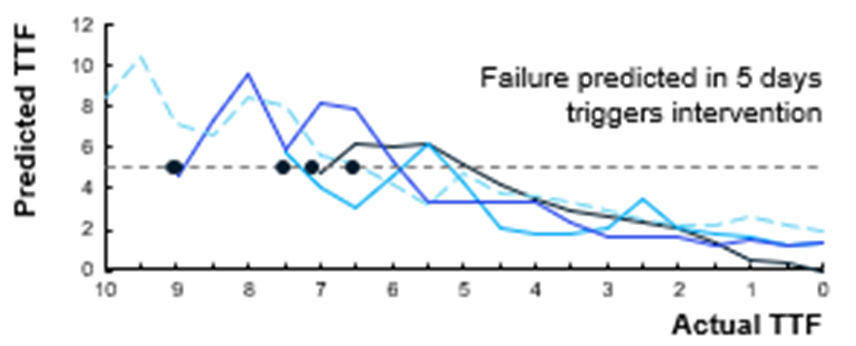
Fig. 11. AI-model of predictive maintenance
The results of implementing this system were impressive. Downtime related to gas compressor failures is expected to be reduced by approximately 70%. Early warnings (more than five days before a potential failure) allowed the average downtime to be reduced from 14 to 4 days, as resources could be planned in advance to prevent catastrophic failures.
Another notable example involves the optimization of gas lift operations in wells. A large international oil company faced suboptimal gas injection parameters at a mature oil field, where natural reservoir pressure was insufficient to maintain production levels. An AI system was developed to optimize gas injection rates to address this issue.
The approach involved analyzing real-time pressure data, gas injection rates, and choke settings to understand production trends and identify underperforming wells. Based on this data, regression models were created, and sensitivity analysis was conducted to generate new production insights. These models were used to identify opportunities to increase production by adjusting operational parameters.
The results of applying this system, as shown in figure 12, illustrate how the AI model analyzes wellhead pressure (WHP) and gas lift rate (GL) to optimize production. For gas-lifted wells, a potential production increase of 50-70% was identified for underperforming wells. Notably, these improvements were achieved without additional capital expenditures, solely through the optimization of existing processes.

Fig. 12. Results of the system application
Another interesting example is the application of AI for automated biostratigraphy. A major European oil and gas company needed to accelerate and automate the process of determining the age of rock formations. Traditionally, this process was performed manually by several biostratigraphers, which was time-consuming and subjective.
To address this challenge, an AI-based system was developed, significantly expanding the database of species used for analysis–from a few hundred in the traditional approach to 60,000. The system created a digital twin of the biostratigraphy process, learning from previous biostratigraphers' results. It analyzed historical well data, including depth and identified fossils, to predict the age of formations.
The results of implementing this system, as shown in figure 13, were impressive. The speed of the process increased tenfold, with 90% of samples requiring no manual review. The system was able to provide continuous age estimates across various depths and categorize predictions into two groups: those with sufficient confidence and those requiring manual verification. This significantly improved the efficiency of geologists and accelerated decision-making in exploration and field development.
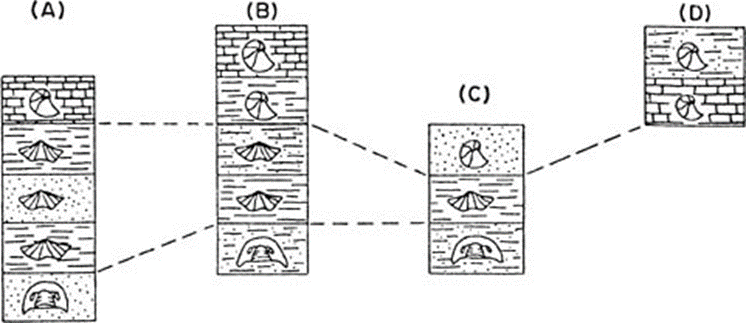
Fig. 13. Results of system implementation
The application of AI in reservoir modeling also demonstrates impressive results. An example of using a surrogate model for black oil reservoir simulation, presented in figure 14, shows how AI can revolutionize this process. The model, trained on data from about 100 simulations, can generate results 100 to 2,000 times faster than traditional numerical solvers. For instance, for a set of 130 simulations, the surrogate model required only 29 minutes, whereas a numerical solver would have taken between 10 and 40 days [11].
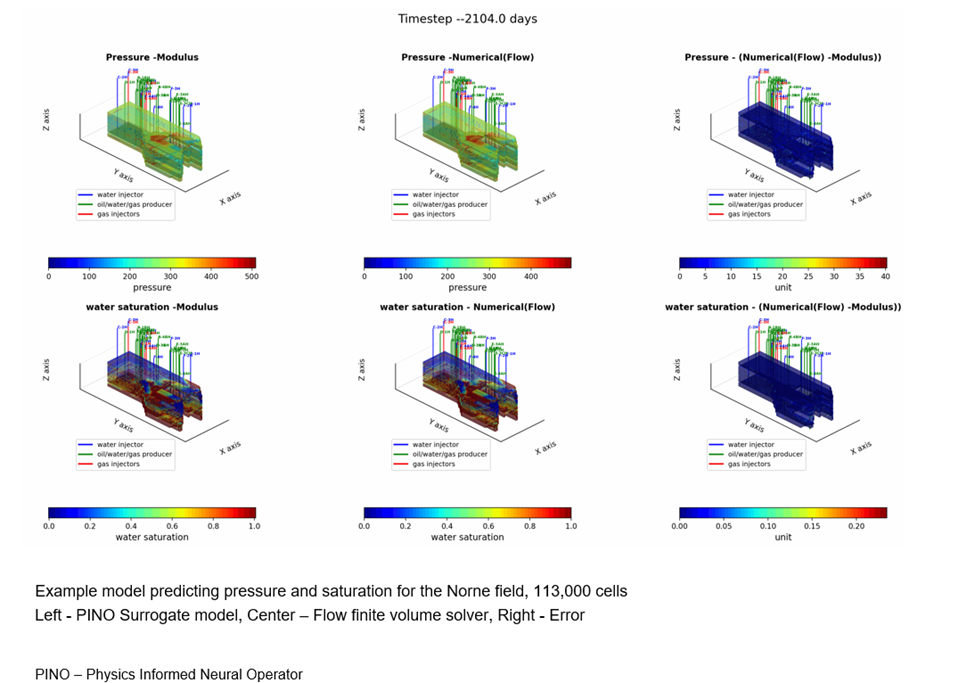
Fig. 14. Example of using a surrogate model to simulate black oil in a reservoir [11]
Another impressive example of AI application, particularly generative AI (GenAI), in the oil and gas industry is the collaboration between Shell and SparkCognition. The companies developed an innovative approach using GenAI to accelerate the process of identifying target structures during subsurface exploration. While the traditional approach to seismic exploration requires significant time and financial investment, as well as enormous computational power, the new GenAI-based method uses deep learning to create reliable images of subsurface structures using far fewer seismic shots.
The results of this project are striking: the new approach allows for obtaining quality images of subsurface structures using only 1% of the data volume required in the traditional approach. This led to a reduction in exploration costs by as much as 99% while maintaining the quality of the subsurface structure images obtained.
The significance of this breakthrough is underscored by statements from key figures in both companies. Gabriel Guerra, Shell's VP of Innovation and Performance, noted: "Generative AI is opening an exciting opportunity to deliver a new wave of innovations at Shell". In turn, Bruce Porter, Chief Science Officer at SparkCognition, emphasized: "GenAI for seismic imaging can positively disrupt the exploration process and has broad and far-reaching implications across industries – driving greater efficiencies, lower cost, and accentuating sustainability initiatives" [12].
Another example of successful AI application in the oil and gas industry is related to the optimization of the drilling process. The use of advanced analytics to process operational drilling data opens up opportunities for significantly increasing drilling efficiency and reducing well construction time.
Modern drilling rigs generate vast amounts of real-time data from various equipment, including drilling tools, logging systems, and more. However, traditional methods of analyzing this data are often limited to simple descriptive statistics, not revealing the full potential of the available information.
The application of advanced analytical methods allows for identifying hidden patterns and trends in these data sets, opening up new opportunities for optimization. For example, AI systems can determine optimal drilling parameters to maximize the rate of penetration (ROP), increase bit life, minimize formation damage, and so on.
The implementation of such AI systems allows for creating analytical dashboards for operational personnel, processing all drilling data flows in real-time. This enables prompt assessment of drilling parameters and operational performance, including:
- Determination of the maximum achievable rate of penetration;
- Assessment of tripping speed versus surge/swab limits;
- Prediction of the remaining life of downhole tools.

Fig. 15. Implementation illustrations (-see source link for more details) [13]
This approach to drilling data analysis not only improves the efficiency of operations but also contributes to more informed decision-making, ultimately leading to significant time and cost savings in well construction.
These examples vividly illustrate how AI is transforming various aspects of the oil and gas industry, from optimizing production and predicting equipment failures to geological exploration and reservoir modeling. They show that implementing AI solutions can lead to significant efficiency improvements, cost reductions, and better decision-making processes in the upstream oil and gas sector [8; 9, p. 2504-2519; 10, p. 181-210].
It is important to note that the successful implementation of AI requires not only technological innovation but also changes in organizational culture and business processes. As these examples demonstrate, companies that successfully integrate AI into their operations gain a significant competitive advantage in the complex and dynamic environment of the modern oil and gas industry.
Conclusion
The conclusion of this paper summarizes the substantial potential of applying artificial intelligence (AI) in oil and gas production, particularly in the upstream segment. The study has thoroughly examined both traditional and innovative AI technologies that are significantly transforming industry practices, leading to enhanced efficiency, reduced costs, and minimized risks.
The application of traditional AI has already proven effective across various stages of the production chain, from geological data analysis and well completion to drilling optimization and predictive maintenance. These technologies enable operators to make faster and more accurate decisions, minimize capital and operational expenditures, and increase overall productivity.
Innovative technologies, such as Deep-Learning Surrogates, Generative AI (GenAI), and generative planning, open new possibilities for further process improvement. These technologies offer more flexible and faster solutions, allowing companies to adapt quickly to changing conditions and gain a significant competitive edge. In particular, they accelerate modeling processes, improve goal-setting and planning, and contribute to reducing development and operational costs.
The prospects for AI in the oil and gas industry remain vast. As technologies evolve and become more integrated into production processes, further increases in efficiency and industry sustainability can be expected. Companies that invest in these technologies and actively implement them in their operations will not only enhance their competitiveness but also significantly reduce costs, improve environmental sustainability, and minimize the risks associated with oil and gas field operations.
In this way, AI has not only already transformed the oil and gas industry but continues to shape its future, offering innovative solutions to complex challenges and creating new opportunities for growth and development.

.png&w=640&q=75)